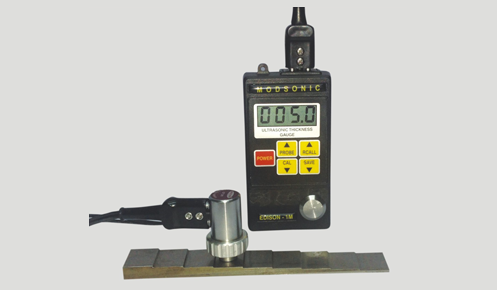In industries where precision is paramount—such as shipbuilding, oil and gas, aerospace, and fabrication—measuring material thickness is a routine and critical task. The tool trusted most for this job is the Ultrasonic Thickness Gauge, valued for its speed, non-destructive nature, and high accuracy. But even the most advanced instrument is only as reliable as its calibration.
So, how often should you calibrate your ultrasonic thickness gauge? The answer depends on a few important factors, including usage frequency, environmental conditions, material types, and the specific application. In this blog, we’ll explore why calibration matters, how often it should be done, and best practices to ensure accurate, dependable readings every time.
What Is Calibration?
Calibration is the process of adjusting your Ultrasonic Thickness Gauge to ensure it provides accurate measurements. It involves comparing the device’s output with a known reference standard—typically a calibration block of a specific material and thickness—and making adjustments so the readings align with the true values.
Without proper calibration, even the most sophisticated ultrasonic gauge can yield misleading results. In fields like structural inspection or pressure vessel maintenance, those inaccuracies could lead to poor decisions, safety risks, or compliance violations.
Why Calibration Matters
Before diving into the “how often,” it’s important to understand the “why.” Calibration is critical for several reasons:
✅ Accuracy
Calibration ensures your thickness measurements reflect the true condition of the material. Even a slight deviation can affect weld quality, structural integrity, or safety compliance.
✅ Consistency
Accurate calibration guarantees that results are repeatable and consistent across time, technicians, and equipment.
✅ Compliance
Many industries require documented evidence that ultrasonic devices are calibrated to traceable standards. These may be dictated by ISO, ASME, API, or other regulatory bodies.
✅ Reliability in Harsh Conditions
Temperature extremes, vibration, drops, or exposure to dust and moisture can affect the internal electronics of your gauge. Regular calibration corrects any minor shifts before they lead to major errors.
How Often Should You Calibrate?
There is no one-size-fits-all answer, but the following guidelines are generally accepted across industries:
1. Daily or Per Shift
If your Ultrasonic Thickness Gauge is used heavily (e.g., multiple hours a day or in critical inspections), you should calibrate it at the start of each day or shift.
This is especially important if:
-
You work in changing temperatures
-
You’re switching materials
-
You’re conducting high-stakes inspections (e.g., pressure vessels or ship hulls)
-
The device has been dropped, bumped, or stored improperly
2. Before and After Each Measurement Session
Even if you’re only using your gauge occasionally, it’s best practice to calibrate before and after each session. This allows you to confirm the instrument remained accurate throughout your inspection.
If there’s any drift between pre- and post-session calibration checks, it may indicate the gauge needs servicing or more frequent recalibration.
3. After Changing the Probe or Cable
Swapping transducers or using different probe types (e.g., for curved vs. flat surfaces) can affect signal transmission. Always calibrate your gauge after changing accessories.
4. Monthly or Quarterly Bench Calibration
Depending on how often the gauge is used, a formal calibration check every 1–3 months using certified reference standards is recommended. This may be done in-house or sent to a certified lab.
Keep a record of these calibrations for audit trails and compliance documentation.
5. Annual Professional Calibration
Regardless of usage, most manufacturers recommend an annual calibration by an authorized service center. This ensures that both hardware and software are functioning optimally and that any internal drift is corrected.
Signs Your Gauge Needs Immediate Calibration
In addition to routine schedules, watch for signs that your Ultrasonic Thickness Gauge may require immediate recalibration:
-
Readings suddenly fluctuate or are inconsistent
-
You’ve dropped the device or exposed it to extreme temperatures
-
Results no longer match known material thicknesses
-
Switching materials yields unexpected results, even after adjusting velocity
-
The gauge displays error messages or loses signal unexpectedly
If in doubt, calibrate before continuing. It’s better to lose five minutes than risk an inaccurate report.
Calibration Methods for Ultrasonic Gauges
Understanding how to calibrate your device is just as important as knowing when. Here are the main methods:
✅ Single-Point Calibration
Uses one known thickness standard. Suitable when measuring consistent material types and thicknesses. Simple and fast.
✅ Two-Point Calibration
Involves two different known thickness standards. This is more accurate, especially when measuring across a range of thicknesses or on materials that don’t transmit sound linearly.
✅ Velocity Calibration
When the material thickness is known, but the sound velocity is not. This method lets the gauge calculate the material velocity and adjust future readings accordingly.
For most applications, two-point calibration offers the best balance of speed and accuracy.
Best Practices for Reliable Calibration
Follow these tips to get the most from your ultrasonic thickness gauge:
1. Use Certified Calibration Blocks
These should match the material you’re testing and be traceable to recognized standards (e.g., NIST or ISO). Don’t rely on guesswork or unverified materials.
2. Apply Quality Couplant
Ensure a consistent ultrasonic signal by using the correct couplant gel or fluid, especially when working in extreme temperatures or with rough surfaces.
3. Stabilize the Environment
Calibrate in conditions similar to your testing environment. Changes in temperature, humidity, or surface condition can impact accuracy.
4. Use the Right Probe
Select the correct transducer for your material and thickness range. High-frequency probes are better for thin materials, while low-frequency probes penetrate deeper.
5. Document Everything
Keep a log of all calibration dates, results, and any anomalies. This supports audit trails and allows for performance tracking over time.
Industry Example: Ship Maintenance
In marine inspections, ultrasonic thickness gauges are used to measure hull plating, tank walls, and piping. Saltwater corrosion and coating layers make accuracy even more critical.
In such conditions, daily calibration and multiple checks per session are standard practice, especially when readings are used to determine whether repairs are required or the vessel is fit to sail.
Choosing a Reliable Device: Why Cygnus Instruments Stands Out
When selecting a gauge that you can trust to hold calibration—and perform consistently in demanding environments—Cygnus Instruments is a name professionals rely on.
As a leading manufacturer and supplier of ultrasonic thickness gauges, Cygnus Instruments is known for:
-
Multiple-echo technology that allows readings through coatings without removing paint
-
Rugged, waterproof construction ideal for industrial and marine use
-
Simple calibration features that make accuracy easy to maintain, even in the field
Whether you’re inspecting offshore platforms, pipelines, ship hulls, or structural steel, Cygnus gauges offer the precision and durability you need.
Final Thoughts
A well-maintained Ultrasonic Thickness Gauge is one of the most reliable tools in your inspection toolkit—but only when it’s properly calibrated. Calibration is not a one-time setup—it’s a recurring quality check that ensures your data is trustworthy, your reports are accurate, and your work meets safety standards.
By understanding when and how to calibrate, you can avoid costly errors, extend the life of your equipment, and deliver results your clients and inspectors can trust.
In summary:
-
Calibrate daily if you’re using the gauge regularly
-
Calibrate before and after each session
-
Perform professional calibration annually
-
Respond to any signs of drift or inconsistency immediately
And most importantly, choose equipment from trusted manufacturers like Cygnus Instruments, whose technology and support ensure you’re always working with confidence.



